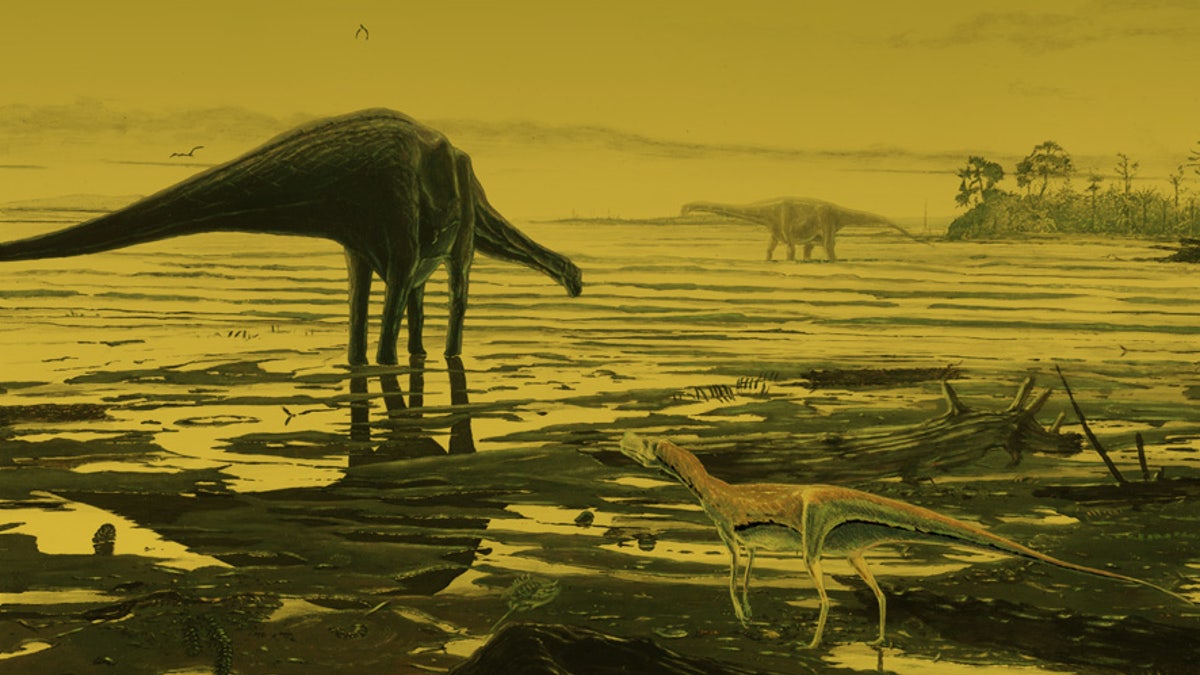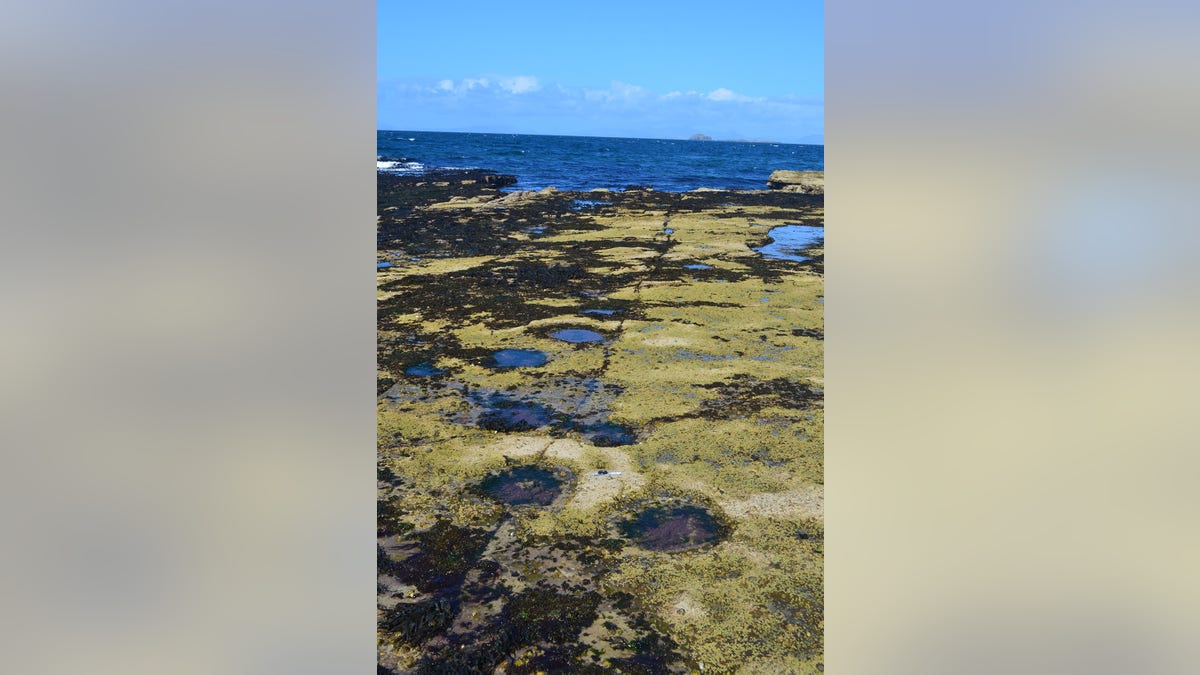
Artist's impression of sauropod dinosaurs on Skye. (Jon Hoad)
Paleontologists have found what they believe is the biggest dinosaur site in Scotland, one that includes hundreds of huge footprints from plant-eating sauropods dating to around 170 million years ago.
The discovery on the Isle of Skye of the footprints and hand prints is helping provide fresh insight into the huge, long-necked animals, which were the biggest of the dinosaurs. A land mammal that fed on plants, this discovery offers the strongest proof yet that they weren’t afraid to occasionally dip their toes into the water.
“This find clearly establishes the Isle of Skye as an area of major importance for research into the Mid-Jurassic period,” University of Edinburgh’s Tom Challands, who took part in the discovery that was detailed in a study Tuesday in the Scottish Journal of Geology, said in a statement. “It is exhilarating to make such a discovery and being able to study it in detail, but the best thing is this is only the tip of the iceberg. I'm certain Skye will keep yielding great sites and specimens for years to come.”
Related: With new discovery, Bolivia has most dinosaur footprints on earth
Scientists had gone to Isle of Skye in April on of their annual fossil trips and stumbled upon the footprints by chance. Heading back from a long day of fossil digging on the island’s isolated far northeast, the team led by Steve Brusatte noticed depressions -some as big as 27 inches in diameter - in the rocks and quickly realized they had found something significant.
“As we were walking back to the cars, we noticed this big depression in the rock, this platform of rock that juts out into the Atlantic. It kind of looked like a pot hole,” Brusatte told FoxNews.com. “Then, we noticed another one and another one in a zigzag pattern. It dawned on us pretty quickly that we had seen similar things in other parts of the world and that these were footprints of these big sauropods.”

Tracks made by sauropod dinosaurs on Skye 170 million years ago. (Steve Brusatte)
Related: Huge trove of dinosaur footprints discovered in Alaska
The site had been visited by other geologists but the foot prints probably were missed because the area is a tidal site often covered by water, seaweed and sand.
“We were just there at a lucky time,” Brusatte said of the footprints, which were the first sauropod tracks to be found in Scotland. Until now, the only evidence that sauropods lived in Scotland came from a small number of bone and teeth fragments.
“When we looked closely at them, we could see the individual digits, impressions of the fingers and toes and the claws. Really, it was in a few minutes that we figured it out,” Brusatte said. “Just right place at the right time and it came together. We frantically started taking a lot of photos, measurements and notes because it was getting dark and the tide was coming in.”
By analyzing the footprints, the team believes that the dinosaurs that lived here were early, distant relatives of more well-known species, such as Brontosaurus and Diplodocus. The Skye dinosaurs likely grew to at least 49 feet in length and weighed more than 10 tons – though they haven’t found any bones that would have come from the dinosaurs because they most likely washed out to sea or were taken away by predators.
Related: Area with 200-plus dinosaur tracks opening to public soon
The tracks are also helping scientists get a clearer idea of habitat and behavior of these behemoths that are believed to have lived alongside other meat-eaters, armored dinosaurs like stegosaurus as well as small mammals.
Together with similar tracks found recently in other parts of the world, the Skye trackways reveal that sauropods spent lots of time in coastal areas and shallow water – and were not solely land based. There have been previous discovers suggesting this was the case but Brusatte said Skye was a “slam dunk site” that supported that theory.
“The reason why the site is so important is that these footprints were made in a lagoon. We know from the geology this was a lagoon,” Brusatte said. “Sauropods were making their foot prints while they were wading in the water … We have three different layers so that is three different time intervals. This is telling us these huge dinosaurs lived or at least moved through these lagoons fairly regularly over time. This was a normal part of their repertoire.”
But what were they doing there?
“They weren’t sharks or whales but they were at home in shallow water,” Brusatte said.
“It doesn’t seem like it was some kind of fluke or random occurrence that they were there They must have just been at home in these environments," he continued. "Maybe they were eating there. Maybe it was a place where there weren’t so many predators so they were a bit safer. Maybe it was a way for them to cool themselves down. We don’t really know. This is a whole new question now that is kind of emerging.”
"Any dinosaur remains such as these Middle Jurassic remains are extremely rare world-wide and are important additions to our knowledge of this poorly represented time period," added Neil Clark curator of Palaeontology at the The Hunterian museum in Glasgow. "Scotland is fast becoming one of the most important sources of Middle Jurassic dinosaurs with new discoveries being made almost every year."
